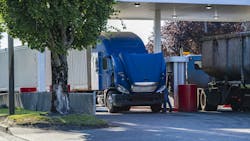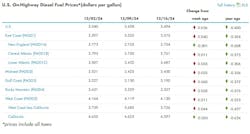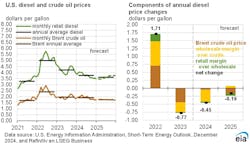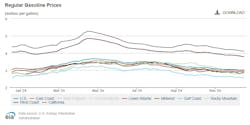As temps drop, diesel prices rise, gas hovers above $3/gal
Diesel prices jumped up across most of the nation the week of December 16, according to U.S. Energy Information Administration tracking. The national average reached $3.494 per gallon, 3 cents higher than last week but 40 cents lower than this time last year.
But despite the uniformity of the price increases across the country, they weren’t as marked as they could be. Price changes varied from less than a cent to 6 cents across the country, with prices dropping less than a cent in the New England sub-region to $3.754 and 2 cents in California to $4.597 per gallon.
According to Matt Muenster, chief economist at Breakthrough, part of the reason for the general decrease in fuel prices for the West Coast and that California’s diesel costs have continued to decline is how diesel inventories have built up over the past few weeks.
“The growing supply creates downward price pressure on the refining premium (or crack) for diesel and the prices decreased across regions,” Muenster explained. “The West Coast has experienced diesel stock builds since the end of October, with larger builds in recent weeks driving down the regional price premium.”
According to the economist, the West Coast has seen the most significant regional decline in pricing, even with the region’s slight price increase this week of 1 cent up to $4.130/gal. For the other regions that experienced a diesel price increase, the Rocky Mountain’s fuel prices, which have been falling since October 28, finally ticked upward 2 cents to $3.357. The Midwest’s diesel prices rose 2 cents as well to $3.450, while both the West Coast without California and the East Coast’s prices increased 4 cents to $3.726 and $3.575 per gallon, respectively. However, the Gulf Coast was hit the hardest by recent price increases, where costs went up by 6 cents to $3.190.
One potential reason for these price shifts is the cold fronts moving through the U.S.
“We continue to expect seasonal weakness for gasoline and diesel prices during the next few months based on seasonal supply-demand trends,” Muenster said. “Refinery maintenance beginning near the middle of the first quarter of 2025 may offer some upward price pressure for products. A particularly cold winter may also support heating oil demand in the NE U.S. which can contribute to upward price pressure for diesel in that region.”
But, with all of this said, the Gulf Coast is still the cheapest place to buy diesel fuel at $3.190/gal, while California is the most expensive at $4.597.
In this case, the EIA’s findings very nearly align with the AAA motor club‘s, with the latter logging a current diesel average of $3.496 per gallon. This displays a 2-cent decrease from the motor club’s findings last week ($3.512), and a 53-cent drop from this time last year ($4.032).
EIA’s last Short-Term Energy Outlook for 2024
Another factor to consider regarding the U.S.’s diesel prices comes from the EIA’s most recent Short-Term Energy Outlook. Released on Dec. 10, the STEO anticipates that due to OPEC+’s second delay in production increases (originally anticipated for January 2025, now the organization expects to delay until April 2025), oil production increases are likely to come from non-OPEC countries. However, this is a good sign for U.S. diesel drivers.
“The prolonged cuts from OPEC+ are a signal that there is adequate oil in the market and that there remains concern among those oil producers that additional supply in the market would push prices lower,” Muenster commented. “Oil prices account for more than half of the final prices of gasoline and diesel at their present price levels, so this signals that we can continue to expect limited upward price pressure, particularly during the first half of 2025.”
With this, the EIA anticipates that global oil production will increase by 1.6 million barrels per day in 2025, with the average price per barrel sticking around $74.
The STEO also noted that increasing U.S. crude oil production is “supplying an almost equivalent increase in U.S. refinery runs.” With this, the EIA anticipates that U.S. crude oil production will continue to increase in 2025, but that U.S. refiners will process less crude oil in 2025, decreasing net crude oil imports to 1.9 million barrels per day. If this occurs, this would be the least net imports of crude oil since 1971, according to the EIA.
Muenster noted that this difference is due to recent refinery closures, citing how Phillips 66 is planning to shut down its Los Angeles-area oil refinery and how LyondellBasell Industries is closing its Houston refinery, both in 2025.
See also: Diesel dips below $3.50; gas flirts with sub-$3 for first time since 2021
“Depending on supply-demand balance they could leave regional refined product balances tighter,” Muenster said. “Vehicle fuel efficiency gains and the continuing growth of alternative energy consumption will help decrease demand to counter this supply loss.”
As for how these changes will impact diesel prices, the EIA noted that they anticipate monthly retail diesel rates to be below average at the start of 2025 but to rise over it at about the mid point of the year.
Gasoline costs slip back above $3
While gasoline pump prices did not increase as uniformly as diesel prices, the EIA’s average has still refused to dip below $3, with this week’s price at $3.016. This is less than a cent more expensive than last week ($3.008) and only 3 cents less than this time last year.
Across the country, gas prices vacillated from less than a cent to 7 cents, with prices rising 5 cents in the Rocky Mountain region to $2.839. Gas costs also rose 7 cents in the Midwest to $2.884/gal. On the other hand, prices dropped less than a cent along the East Coast to $2.991 and fell 3 cents along the West Coast without California to $3.445. California’s gas costs dipped 4 cents, as did the West Coast’s overall and the Gulf Coast. California reached $4.096 per gallon, the West Coast overall reached $3.785, and the Gulf Coast reached $2.562 per gallon, respectively.
This leaves the Gulf Coast as the cheapest place for gas at $2.562 and California as the most expensive at $4.096 per gallon.
As a point of comparison, the AAA gas average is currently $3.024 per gallon, barely more expensive than the EIA’s numbers. The motor club’s current gas cost is also more expensive than last week’s of $3.018, but 5 cents cheaper than last year’s of $3.075 per gallon.
“I’d like to say that the national average will fall under $3 soon, but now I’m not so confident,” said Andrew Gross, AAA spokesperson. “It appears to be stuck despite low demand and cheaper oil. But 31 states already have an average below $3.”
About the Author
Alex Keenan
Alex Keenan has been associate editor for Endeavor's Commercial Vehicle Group, which includes FleetOwner magazine, since 2022. She has written on a variety of topics for the past several years and recently joined the transportation industry, reviewing content covering technician challenges and breaking industry news. She holds a bachelor's degree in English from Colorado State University in Fort Collins, Colorado.



